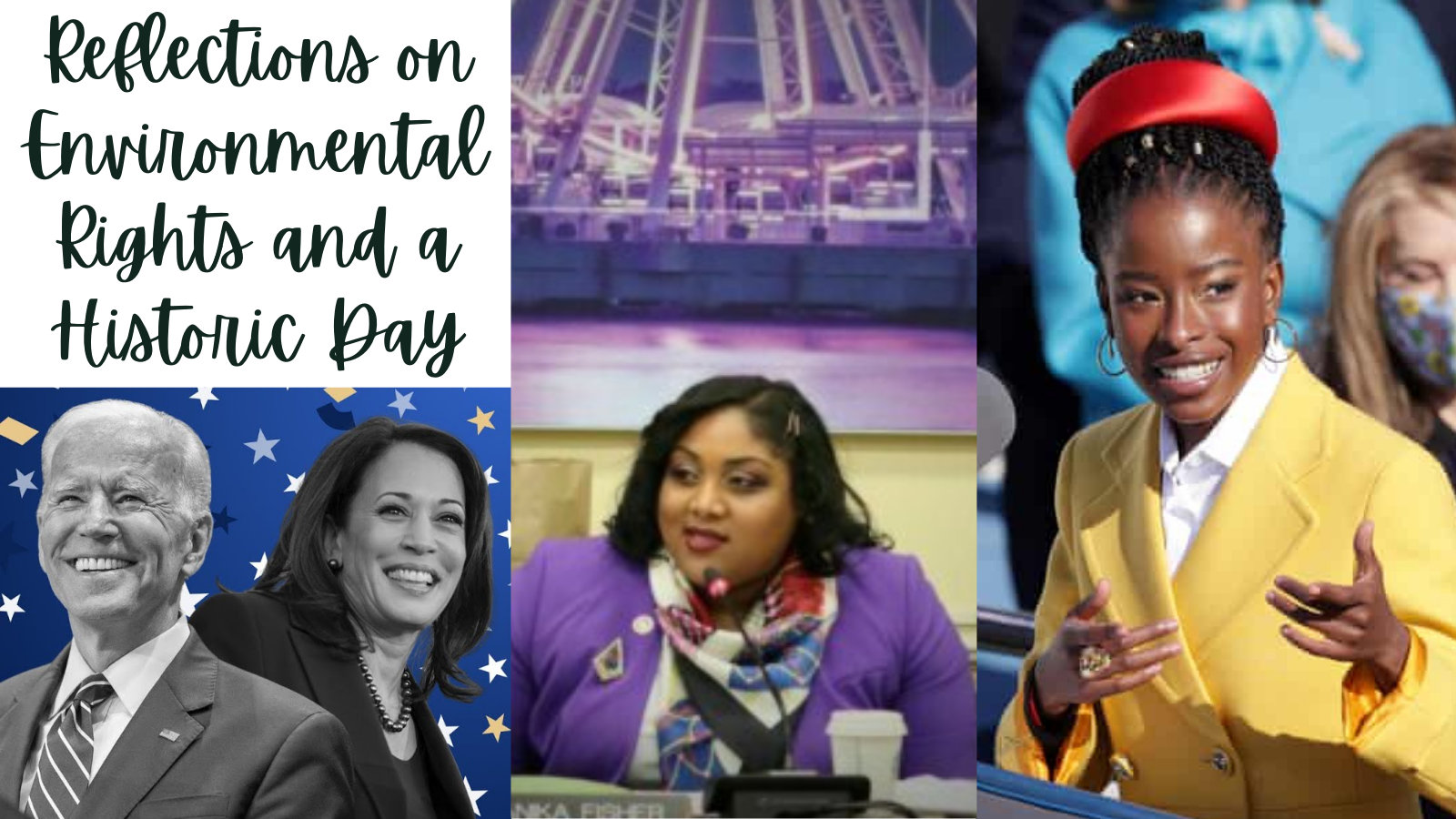
As I waited in the House of Delegates Zoom waiting room to testify on behalf of the Sierra Club Maryland Chapter on a Maryland Constitutional Amendment for Environmental Rights... I couldn’t help reflecting upon the historic day, January 20, 2021. I sat exhilarated, still nervous, yet hopeful, a mere 90 minutes after the inauguration of the 46th President dedicating to bring enough of us together to move all of us forward, and the First African American, First Asian American, First Woman, Vice President. What a day to be alive.
In times of crisis, we fall back on our fundamental rights to free speech, free press, to vote and to peaceably assemble. When our nation was gripped by the struggles of recognizing the racism embedded in our institutions, and fighting against the mounting demonstrations of white supremacy, we valued our rights to peaceably assemble and use our speech and press to proclaim loudly that until black lives matter, all lives matter cannot ring truthfully from our lips. The continual struggle in society to balance one's individual liberties with the needs of a society as a whole is not lost on me today as I hear lawmakers wondering why we need environmental rights codified in the Maryland constitution. As we face the growing climate emergency, we reckon with the effect of our society on the Earth 's air, water and abundant biodiversity. We would be doubly remiss in failing to recognize the impact that the environment has on our bodies, our health, and our survival.
It’s simple: cleaner air leads to healthier children. Yet almost 90% of Marylanders live in areas with unhealthy air as designated by the EPA. Baltimore has the highest rate of asthma in the United States. (1) Transportation is the number one source of greenhouse gases. (2) Six coal burning plants in Maryland in 2019 produced 14% of Maryland’s power in 2019 (3) but produced over 50% of our carbon dioxide, over 75% of nitrous oxide and over 90% of the sulfur dioxide.
We know the link between burning coal and chronic conditions like asthma. We know that race, not class, is the number one indicator of where a toxic pollution source is located. (4) We see the disproportionate burden of incinerators, highways, power plants, and heavy industry on communities of color as health impacts.
During the pandemic, the disproportionate devastation on communities of color has been evident in every analysis of infections, severity and death. (5)
We must face facts. Systemic racism devestatates both our climate and collective humanity. How then, will we protect our children from the health impacts of environmental racism? How do we reckon with the greed and hate of a few, the complacency of the many, to protect the health and survival of all? How to remedy the underlying issues that we see present in our flooding city, our coastal state, a fragile democracy and a warming planet?
There is evidence and precedent that a constitutional amendment that enshrines environmental rights into law is effective and legally prudent.
The New York State Bar Association’s Environmental and Energy Law Section published a detailed analysis and recommended the adoption of a constitutional environmental right. (6) A 2013 Yale UNITAR workshop provides insight into the effectiveness of constitutional environmental rights as well as the extent to which countries are taking environmental human rights seriously. It is telling to share that, "As of 2013, 182 of the world’s 193 UN member nations recognize this right, either through their constitution, environmental legislation, court decisions, or ratification of an international agreement. The only remaining holdouts are the US, Canada, Japan, Australia, New Zealand, China, Oman, Afghanistan, Kuwait, Lebanon, and North Korea.
Even among these laggards, some sub-national governments recognize the right to a healthy environment, including six American states, five Canadian provinces or territories, and a growing number of cities." (7) Maryland must not wait until our beloved coastline is underwater to enact the Maryland constitutional amendment for environmental rights. We must join as leaders across the country and worldwide to value and codify the right to a healthful environment.
The amendment will protect the rights of all Marylanders to live in a healthful environment, including clean air, water, land, and a stable climate. It will also recognize the state as trustee of Maryland’s natural resources. Protecting everyone’s right to live in a healthy environment in our state constitution and requiring the state to protect those rights resets the priority of the government to put the health of the planet and the public first.
I am reminded of the words I heard just an hour ago, poet Amanda Gorman: “And the norms and notions, of what just is, Isn't always just-ice, And yet the dawn is ours…”
Today, with a fragile democracy, raging pandemic, and warming planet, we ask to codify the right to live and breathe in a healthy climate into the Maryland Constitution.
Rosa Hance,
Chapter Chair, Maryland Sierra Club
-------------
HB82/SB151 – the Maryland Constitutional Amendment for Environmental Rights - Committee - State Senate sponsor O. Patterson, House of Delegates sponsor W. Fisher
Coming up next… Senate Hearing Date: January 26, 2021